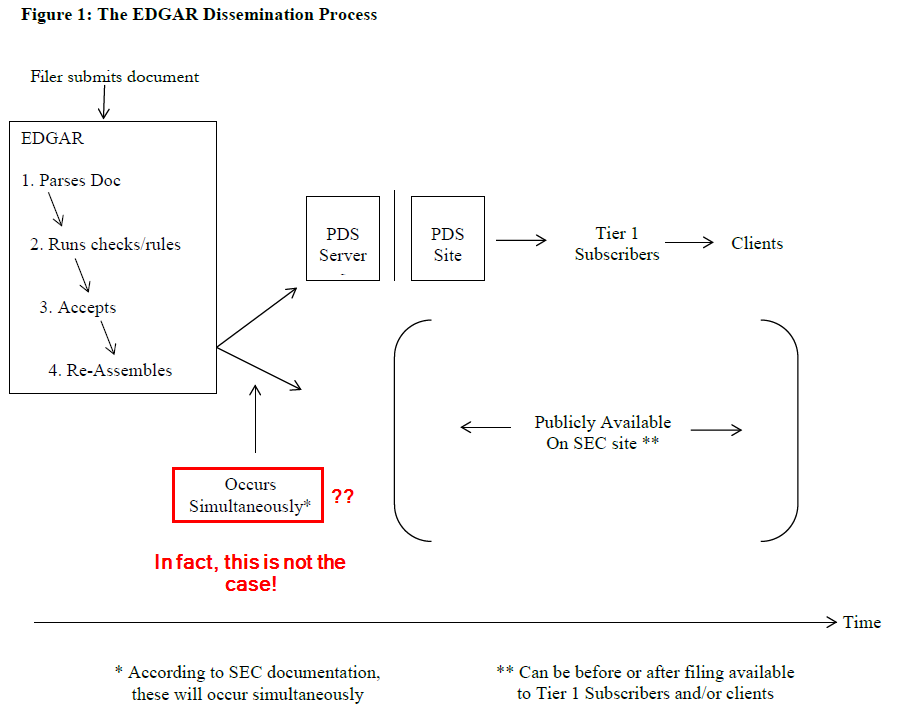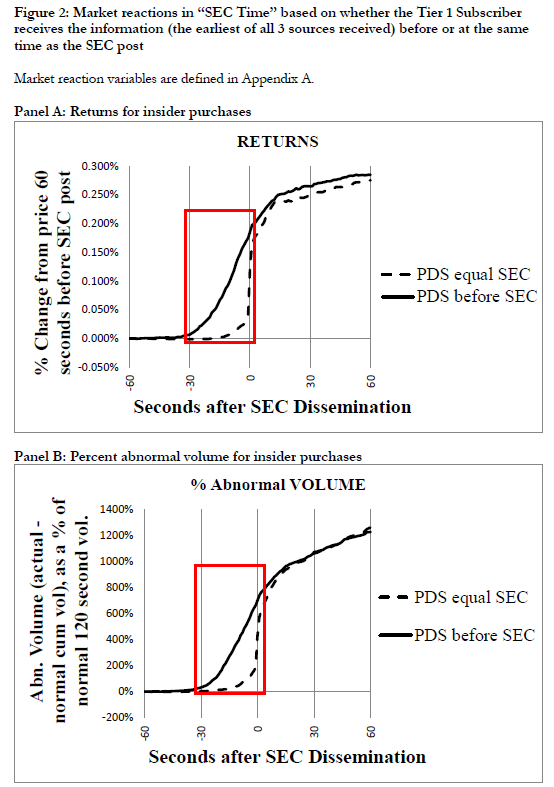Run EDGAR Run: SEC Dissemination in a High-Frequency World
- Rogers, Skinner and Zechman
- A version of the paper can be found here.
- Want a summary of academic papers with alpha? Check out our Academic Research Recap Category.
Abstract:
We use a large recent sample of Form 4 insider trading filings to provide evidence on the process through which SEC filings are disseminated via EDGAR. We find that while the delay from a filing’s acceptance by EDGAR to its initial public availability on the SEC website is relatively short, with a mean (median) posting time of 40 (36) seconds, in the majority of cases the filing is available to Tier 1 subscribers before its availability on the public SEC site. We further show that prices, volumes, and spreads respond to the filing news beginning around 30 seconds before public posting, consistent with some market participants taking advantage of the posting delay. These results raise questions about whether the SEC dissemination process is really a level playing field for all investors.
Alpha Highlight:
A classical image of old-time stock trading: buyers and sellers gather together on the exchange trading floor and bargain loudly until the market clears. Now sophisticated computer algorithms can trade a million shares at the speed of light. The common term for this sort of trading is officially known as High-frequency trading (HFT).
In this high-frequency world, high-speed trading can take advantage of every microsecond! Here is a WSJ article named, “Traders Pay for an Early Peek at Key Data.” The article highlights an interesting situation where HFT clients would pay Thomson Reuters $5,000 a month to access data two seconds before other clients.
It seems that speed matters when it comes to information acquisition.
This paper investigates the role speed plays in the context of insider trading.
Form 4 is the form used by insiders to report their trades. This information is disseminated via the SEC website. The process for information dissemination is outlined in Figure 1.

After a public company submits documents, the SEC’s EDGAR system will process the information and then deliver to both the Public Dissemination Services (PDS) and SEC website simultaneously. The PDS are responsible for transmitting the data to paying Tier 1 subscribers.
According to SEC documentation, dissemination to Tier 1 subscribers occurs at the same time or after data are publicly-available on SEC website…
BUT the paper finds that it is not the case!
Two core questions were studied in this paper:
- Is there a timing advantage available to Tier 1 subscribers?
- If the answer of Q1 is “yes”, then does the timing advantage lead to a trading advantage?
Key Findings:
1. To answer the first question, the authors obtain 4,782 SEC Form 4 filings samples and compare their SEC post times and Tier 1 subscribers’ PDS feed times.
The results are striking: more than half (57%) are available to the Tier 1 subscribers before SEC public posting! (see table 4) The mean time to initial dissemination to Tier 1 subscribers is 30 sec, while the meantime to initial SEC public posting is 40 sec.
While the time differences are measured in seconds, these delays mean a lot in a high-frequency trading world.
2. The second question asks about the economic significance of this time difference. To address this question, the authors test market responses to such timing issues, regarding changes in prices, abnormal volumes and abnormal returns. The results show that some traders do take advantage of knowing about the insider purchases in advance of public dissemination.
Changes in prices: Panel A shows that price moves upward for advantaged observations (PDS before SEC) around 30 sec before public posting. While for the non-advantaged observations (PDS equal SEC), the upward shift in price occurs exactly at the time of posting.
Changes in abnormal volumes and returns: Panel B shows similar results in abnormal volume.

Watching insider trading filings without a computer and Tier 1 subscription status? Be careful!
About the Author: Wesley Gray, PhD
—
Important Disclosures
For informational and educational purposes only and should not be construed as specific investment, accounting, legal, or tax advice. Certain information is deemed to be reliable, but its accuracy and completeness cannot be guaranteed. Third party information may become outdated or otherwise superseded without notice. Neither the Securities and Exchange Commission (SEC) nor any other federal or state agency has approved, determined the accuracy, or confirmed the adequacy of this article.
The views and opinions expressed herein are those of the author and do not necessarily reflect the views of Alpha Architect, its affiliates or its employees. Our full disclosures are available here. Definitions of common statistics used in our analysis are available here (towards the bottom).
Join thousands of other readers and subscribe to our blog.

